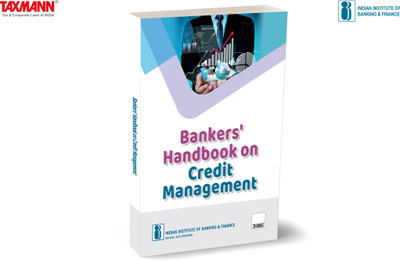Iibf X Taxmann's Bankers' Handbook on Credit Management(English, Paperback, unknown)
Quick Overview
Product Price Comparison
The 'Bankers' Handbook on Credit Management' is developed to address the unique skill requirements of banking professionals in managing credit portfolios. This book offers insights into the credit function, supplemented by practical examples, a rundown of regulatory guidelines, etc. The focus areas of this handbook revolve around the credit operations of commercial banks and delve into: (i) An Introduction to and Overview of Credit (ii) Analysis of Financial Statement (iii) Working Capital Management (iv) Other Credits (v) Monitoring, Supervision/Follow-up, and Management of Impaired Assets Emphasis is placed on real-world applications of credit management concepts and functions. To ensure the reader is well-equipped with the latest knowledge, this book incorporates the recent developments and guidelines in the field. This book is not only the recommended courseware for the IIBF's 'Certified Credit Professional Course', recognized by the Reserve Bank of India & Indian Banks Association for enhancing the skills of banking professionals, but also an invaluable asset for anyone intrigued by the nuances of bank credit functions within India. The Present Publication is the 3rd Edition, updated by P.D. Sankaranarayanan (Former Assistant General Manager ŌĆō State Bank of India) and vetted by D. Srinivasan (Former Deputy General Manager & Faculty | Training College ŌĆō Indian Bank). Taxmann exclusively publishes this book for IIBF with the following coverage: (i) Module A ŌĆō Introduction & Overview of Credit (a) Principles of Lending (b) Credit Policy (c) Types of Borrowers & Types of Credit Facilities (d) Credit Delivery (e) Credit Appraisal (f) Credit Rating (g) Capital Adequacy (Credit Risk ŌĆō Standardized Approach & Advanced Approached) (1) Probability of Default (2) Exposure at Default (3) Loss Given Default (h) Importance & Application of RAROC (Risk Adjusted Return on Capital) (ii) Module B ŌĆō Analysis of Financial Statements (a) Analysis of Financial Statements (b) Non-financial Risk Analysis & Macroeconomic Factors (c) Project Appraisal/Term Loan Appraisal (d) Credit Risk Analytics & Credit Scoring Models (iii) Module C ŌĆō Working Capital Management (a) Working Capital Assessment (including Factoring, Bill Financing, etc., as Sub-limits) (b) Non-Fund-Based Credit Facilities (iv) Module D ŌĆō Other Credits (a) Export Finance (b) Priority Sector Lending/Government Sponsored Schemes/NABARD Schemes (c) Retail Loans (d) Forward Exposure Limit & Pre-settlement Risk (e) Structured Finance Options (f) Alternative Source of Funding (g) Digital Finance-P2P Lending via FinTech (h) Green Finance (v) Module E ŌĆō Monitoring, Supervision/Follow-Up & Management of Impaired Assets (a) Documentation (b) Types of Charges (c) Follow-Up, Supervision & Credit Monitoring (1) Periodic Scrutiny of Exception Reports (2) AI/ML Based Analytics Tools to Analyze the Transaction to Predict 'Likely to Default' (d) Resolution of Stressed Assets (e) Fair Practices Code on Lender's Liability (f) Insolvency & Bankruptcy Code (IBC), 2016 [including all Amendments & Top Five Judgements] (g) Fraud Risk Management in Credit (1) Early Warning Signals [Annexure 16/3 of Current Book] (2) Red Flagging of Accounts (3) Identification & Reporting of Fraud (4) Forensic Audit (5) Wilful Defaulters (6) Non-cooperative Borrowers (7) Fugitive Economic Offender (8) Look Out Circular (9) Criminal Offenses and Investigative Agencies


